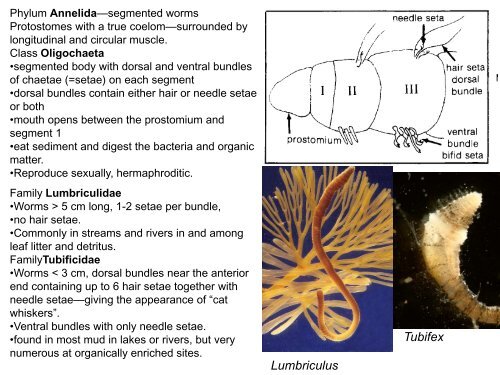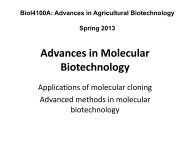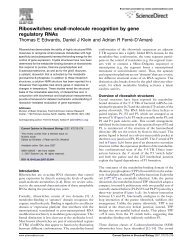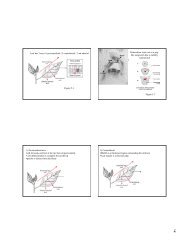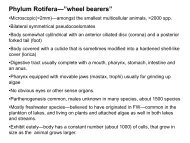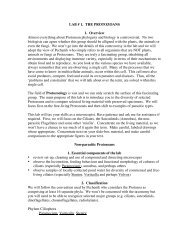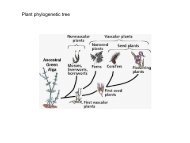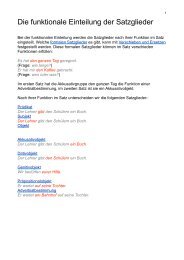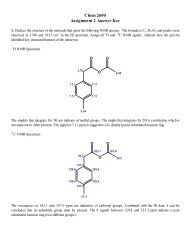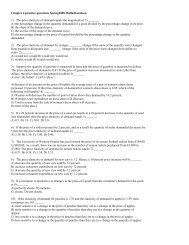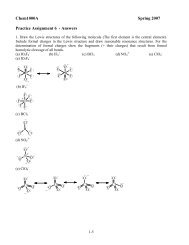Create successful ePaper yourself
Turn your PDF publications into a flip-book with our unique Google optimized e-Paper software.
<strong>Phylum</strong> <strong>Annelida</strong>—segmented worms<br />
Protostomes with a true coelom—surrounded by<br />
longitudinal and circular muscle.<br />
Class Oligochaeta<br />
•segmented body with dorsal and ventral bundles<br />
of chaetae (=setae) on each segment<br />
•dorsal bundles contain either hair or needle setae<br />
or both<br />
•mouth opens between the prostomium and<br />
segment 1<br />
•eat sediment and digest the bacteria and organic<br />
matter.<br />
•Reproduce sexually, hermaphroditic.<br />
Family Lumbriculidae<br />
•Worms > 5 cm long, 1-2 setae per bundle,<br />
•no hair setae.<br />
•Commonly in streams and rivers in and among<br />
leaf litter and detritus.<br />
FamilyTubificidae<br />
•Worms < 3 cm, dorsal bundles near the anterior<br />
end containing up to 6 hair setae together with<br />
needle setae—giving the appearance of “cat<br />
whiskers”.<br />
•Ventral bundles with only needle setae.<br />
•found in most mud in lakes or rivers, but very<br />
numerous at organically enriched sites.<br />
Lumbriculus<br />
Tubifex
Tubificids are reddish because they contain hemoglobin which permits them to<br />
tolerate the anoxia associated with organically enriched sediments.<br />
Tubificidae<br />
•dorsal bundles with hair and needle setae<br />
http://www.ittiofauna.org/webmuseum/invertebrati/anellidi/images/tubifex.jpg<br />
Tubificids have been found to<br />
be a vector of “whirling<br />
disease” a protozoan parasite<br />
that infects brains of salmonid<br />
fishes
Class Hirudinea—leeches<br />
•Segmented, but lack setae, a sucker at<br />
each end<br />
•Oral sucker with or without jaws or an<br />
extrudable proboscic<br />
•Gut with caecae and a posterior anus,<br />
anterior portion of the gut is distendible<br />
and can hold a large volume of fluid.<br />
•Coeolomic cavity incomplete<br />
•Body musculature, longitudinal and<br />
circular; plus dorsoventral strips which<br />
maintain a flattened shape.<br />
•Swim with an undulatory motion or walk<br />
with an “inchworm” type of movement.<br />
•Sexual reproduction; hermaphrodites.<br />
•Primarily fluid/blood feeders, but some<br />
are also predators on invertebrates.
Family Hirudinidae<br />
•Jawed leeches that suck blood from<br />
vertebrates<br />
•Also Important decomposer of fish carcasses<br />
Eg Macrobdella decora<br />
•Important decomposer<br />
•of fish carcasses.<br />
•Also a blood sucker on mammals<br />
One of the first aquatic species in<br />
Europe to become seriously<br />
endangered was Hirudo medicinalis<br />
Leech salivary glands secrete<br />
hirudin an anticoagulant protein<br />
along with a local anaesthetic.<br />
eye pattern
Percymoorensis marmorata<br />
=Haemopsis<br />
Common blood sucking hirudinid<br />
leech from western Canada<br />
Sometimes called the<br />
“horse leech”
Blood sucking leeches are still used in medicine today<br />
leeches used to prevent scarring (cosmetic applications) and to re-establish circulation in tissue<br />
grafting and limb reattachment operations .<br />
•fluid accumulation in a healing wound is a major contributor to scar formation.<br />
•Leeches drain the fluid from the immediate area of the scar so that it doesn’t accumulate, and<br />
their anticoagulants and neurotransmittors improve local capillary circulation.<br />
•Leech saliva contains hyaluronidase, collagenase, proteases that slow down connective tissue<br />
formation.
A new cure for zits
Family Glossiphoniidae<br />
•mouth a small pore in the oral<br />
sucker which is not distinctly<br />
set off from the rest of body<br />
•jaws lacking<br />
•body distinctly flattened<br />
•Most species predators on<br />
pulmonate snails, some are<br />
predators on small insect larvae<br />
eg chironomids, and some are<br />
blood suckers on vertebrates,<br />
Left Glossiphonia—greenish<br />
leech, with whitish spots and 2<br />
dark lines on the back. 3prs of<br />
eyes equidistant—”snail leech”<br />
Right Helobdella stagnalis—<br />
pale yellowish, no mottling or<br />
striping, 1 pr of eyes, and a<br />
dorsal chitinous scute in the<br />
antero-dorsal region.—predator<br />
on chironomid larvae
Family Erpobdellidae<br />
•jawless leeches with large mouths occupying the<br />
entire cavity of the oral sucker<br />
•predators on invertebrates e.g chironomid larvae,<br />
amphipods, or tubificids— not blood suckers<br />
•ingest the whole prey and then egest or defecate<br />
the indigested cuticles etc.<br />
•3 or 4 pr of eyes in transverse rows.<br />
•Common in lakes, ponds, and slow moving rivers.<br />
In fishless ponds they can be a top predator<br />
Left Nephelopsis obscura—greyish ground colour<br />
with dark mottled pattern<br />
Right Erpobdella punctata—brownish colour with<br />
2-4 longitudinal rows of black spots on the dorsal<br />
side<br />
N.obscura E.punctata
<strong>Phylum</strong> Mollusca<br />
Protostome coelomate animals with the body<br />
divided into two regions:<br />
The upper region contains the mantle, the gills,<br />
and the digestive glands<br />
The lower region (foot) contains the mouth,<br />
intestine, the brain and most of the nervous<br />
system.<br />
The mantle secretes a shell of calcium carbonate<br />
Class Gastropoda<br />
Shell univalved, and usually spirally coiled in<br />
either to the right (dextral) or the left (sinistral).<br />
SC Prosobranchia—gill in the mantle cavity and<br />
a flap closing the opening of the shell—operculum<br />
•need O 2-rich water<br />
•evolved from marine ancestors<br />
SC Pulmonata—mantle cavity an air-breathing<br />
lung, no operculum<br />
• can survive in O 2 poor water.<br />
•freshwater pulmonates from terrestrial ancestry<br />
(terrestrial snails and slugs are pulmonates)<br />
•most freshwater snails graze periphyton from<br />
rocks with their radula—a scraping organs in their<br />
mouths.<br />
radula<br />
http://www.emc.maricopa.edu/faculty/farabee/biobk/gastropodanatomy.gif
SC Pulmonata<br />
Family Lymnaeidae<br />
Shell dextrally coiled with a raised spire<br />
No operculum<br />
15-40 mm in length<br />
Sexual reproduction, hermaphroditic, capable<br />
of self fertilization<br />
Family Physidae<br />
Shell sinistrally coiled with a somewhat raised<br />
spire<br />
No operculum<br />
8-20 mm in length<br />
Sexual reproduction, hermaphroditic, capable<br />
of self fertilization<br />
L.elodes<br />
Lymnaea stagnalis<br />
http://members.aol.com/Mkohl2/Images/Lstagnalis150.jpg<br />
Physa gyrina<br />
Aplexa hypnorum<br />
http://www.sunsite.ualberta.ca/Projects/Bio-DiTRL/images/med_jpeg/m28571102.jpeg
Family Planorbidae<br />
Shell coiled into a flat disc –no spire<br />
No operculum<br />
5-25 mm in length<br />
Sexual reproduction, hermaphroditic<br />
SubCl Prosobranchia<br />
Family Valvatidae<br />
Shell dextrally coiled with a somewhat raised<br />
spire<br />
Operculum present<br />
4-8 mm in length<br />
Sexual reproduction, hermaphroditic<br />
Gyraulus<br />
http://www.sunsite.ualberta.ca/Projects/Bio-DiTRL/images/med_jpeg/m28571102.jpeg<br />
Valvata tricarinata<br />
operculum<br />
Helisoma trivolvis<br />
V.sincera
SubCl Prosobranchia<br />
Family Viviparidae<br />
Shell usually dextrally coiled but sinistral<br />
specimens sometimes found.<br />
Operculum present<br />
20-40 mm in length<br />
Population all females, reproduce<br />
parthenogentically<br />
SubCl Prosobranchia<br />
Family Amnicolidae<br />
Shell dextral<br />
Operculum present<br />
4-8 mm in length<br />
Sexes separate (dioecious).<br />
Campeloma<br />
Note sinistral specimen on left<br />
operculum<br />
http://www.jaxshells.org/818g.jpg<br />
http://www.cofc.edu/~dillonr/FWGSC/A_limosa_1a.jpg
Planktotrophic marine gastropod larvae<br />
Newly hatched trochophore larva—<br />
around 100 microns<br />
The trochophore develops into a<br />
veliger, which looks like a tiny snail with<br />
ciliated wings that it uses to feed and<br />
swim with<br />
Planktotrophic gastropod veliger of a<br />
marine snail<br />
The ciliated “wings” that it uses to swim<br />
with develop into the foot when it settles<br />
Some marine gastropods have benthotrophic young that develop from larger eggs<br />
directly into miniature adults, and skip the trochophore and veliger stages.<br />
All freshwater and terrestrial gastropods have benthotrophic young.<br />
http://scaa.usask.ca/gallery/lacalli/tutorial/images/spiralians_trochophore.gif
•Class Pelecypoda—clams and mussels<br />
•bivalved shell (hinged dorsally with ligaments)<br />
•shell closed by anterior and posterior adductor<br />
muscles<br />
•Water drawn into mantle cavity through inhalent<br />
siphon, and leaves through the exhalent siphon<br />
•water current bathes gills, food particles trapped in<br />
mucous, and ciliary motion moves mucous strand<br />
toward the mouth (flanked by labial palps).<br />
•ventral foot wedge shaped and can move through<br />
mud or sand, which most clams bury themselves in<br />
•others attach themselves to rocks, pylons etc using<br />
proteinaceous threads.<br />
•Fossil history of clams dates back to the Cambrian<br />
•Family Unionidae—pearly mussels<br />
•Freshwater mussels evolved from marine ancestors<br />
•Sexes usually separate and eggs hatch into<br />
parasitic glochidia larvae inside the mantle which<br />
leave through the exhalent siphon and attach<br />
themselves to fish gills or fins.<br />
•marine pelecypods generally have planktotrophic<br />
trochophore and veliger larval stages<br />
http://www.assateague.com/clam-dia.gif<br />
http://shells.tricity.wsu.edu/ArcherdShellCollection/Illust<br />
rations/Bivalve_Shell_Features.JPG
Note annual rings > 9 yr<br />
http://www.nature.ca/rideau/b/images/img0065_sml.jpg<br />
Inhalent siphon<br />
Has hair-like papillae that<br />
detect particles too large<br />
to take in, and cause the<br />
mussel to close the<br />
siphon<br />
Exhalent siphon<br />
is situated more<br />
dorsally—closer to<br />
the hinge<br />
Elliptio complanata—a common unionid in Eastern Canada<br />
•North America has >250 species of Unionids, but most have a limited distribution—depend on their fish hosts<br />
for dispersal.<br />
•Natives used them extensively for food, beadwork, and jewelry, and more recently they were the staple of the<br />
button industry, and now the cultured pearl industry.<br />
•More species of Unionidae have gone extinct any other group of aquatic organisms—highly vulnerable to<br />
overharvesting, siltation, agricultural, domestic and industrial pollution of water, damming and channeling of<br />
rivers.
http://cars.er.usgs.gov/pics/db_nativemollusks0261.jpg<br />
Glochidia larva of a unionid
Glochidia attached to a<br />
gill filament<br />
gill of an American Shad hemorraging<br />
because of a heavy glochidia infestation<br />
Reproductive output<br />
•While fw mussels grow very slowly and live a long time, in terms of reproductive output they<br />
are very much r-strategists.<br />
•Female molluscs can release from 200,000—17,000,000 glochidia per season. Young and<br />
Williams (1984) concluded that in a natural population of Megalonaias margaritifera, 1 out of<br />
100,000,000 glochidia lived to become a settled juvenile.
http://asm.wku.edu/faculty/Lienesch/225/225images/gloch.jpg<br />
Lampsilis ventricosa<br />
Some Lampsilis species have evolved to have their inhalent siphon mimic a small<br />
minnow—this attracts larger fish like walleye,perch and bass and when they come near<br />
the clam lets out a cloud of mucous containing thousands of glochidia larvae
http://www.ivb.cz/fish/img/reichard_ri_1.jpg<br />
The relationship between the<br />
bitterling and Unio
http://www.anr.state.vt.us/dec/waterq/lakes/images/ans/lp_zm-stick.jpg<br />
Family Dreisseniidae<br />
Zebra and quagga mussels<br />
Mussels that attach to rocks and<br />
other hard substrates using<br />
proteinaceous threads –byssal<br />
threads<br />
Dreisseniid veligers attach<br />
themselves to the surface of<br />
unionids, which usually leads<br />
to the death of the native<br />
mussels
Life cycle of the zebra mussel—is the ancestral marine mussel life cycle<br />
http://el.erdc.usace.army.mil/zebra/zmis/image/lifehistory2.gif
Shells of dead dreisseniid mussels on the<br />
shores of Lake Erie.<br />
Dreisseniids are endemic to the<br />
Pontocaspian region and have spread<br />
through Europe because of canals and<br />
barges, and to NA in ship ballast<br />
Crayfish<br />
covered by<br />
dreisseniid<br />
mussels
Dreissenia polymorpha—the zebra mussel was first recorded in North<br />
America in 1987—in Lake St. Clair near Detroit, and is believed to have<br />
arrived in ship ballast. Since then it has spread rapidly over much of the<br />
continent.<br />
http://nas.er.usgs.gov/taxgroup/mollusks/zebramussel/maps/current_zm_map.jpg
Family Sphaeriidae—fingernail clams<br />
•Tiny clams (4-10 mm) that live freshwater lakes, ponds<br />
and streams<br />
•Sexes separate (dioecious)<br />
•Ovoviviparous—eggs hatch within mantle cavity, and<br />
young are brooded on the gills and released as fullly<br />
developed offspring (0.6-4 mm)—not parasitic.<br />
•Deposit-feeders, take in mud through their siphons and<br />
digest organic matter and bacteria<br />
•Most sphaeriid species are widely dispersed, and have<br />
extremely broad tolerance ranges. They can live in virtually<br />
any type of aquatic environment with nearly any<br />
temperature or productivity regime.<br />
•While most clams grow very slowly but have enormous<br />
output of larvae, sphaeriids grow and mature rapidly at<br />
small sizes, but give birth to few, but relatively large living<br />
young (parental investment).<br />
Sphaerium<br />
Pisidium


